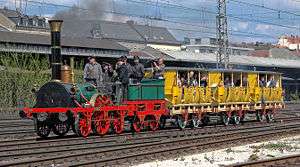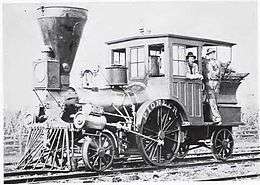2-2-2

Under the Whyte notation for the classification of steam locomotives, 2-2-2 represents the wheel arrangement of two leading wheels on one axle, two powered driving wheels on one axle, and two trailing wheels on one axle. The wheel arrangement both provided more stability and enabled a larger firebox than the earlier 0-2-2 and 2-2-0 types. This configuration was introduced in 1834 on Robert Stephenson's 'Patentee locomotive' but it was later popularly named Jenny Lind, after the Jenny Lind locomotive which in turn was named after the popular singer. They were also sometimes described as Singles, although this name could be used to describe any kind of locomotive with a single pair of driving wheels.
Equivalent classifications
Other equivalent classifications are:
- UIC classification: 1A1 (also known as German classification and Italian classification)
- French classification: 111
- Turkish classification: 13
- Swiss classification: 1/3
History
The 2-2-2 configuration appears to have been developed by Robert Stephenson and Company in 1834, as an enlargement of their 2-2-0 Planet configuration, offering more stability and a larger firebox. The new type became known as Stephenson's Patentee locomotive.[1] Adler, the first successful locomotive to operate in Germany, was a Patentee supplied by Robert Stephenson and company in component form in December, 1835 was one of the earliest examples. Other examples were exported to the Netherlands, Russia and Italy.[2] By 1838 the 2-2-2 had become the standard passenger design by Robert Stephenson and Company.[3]
Eighteen of the first nineteen locomotives ordered by Isambard Kingdom Brunel for the opening of the Great Western Railway in 1837/8 were of the 2-2-2 type.[4] These included six 2-2-2 locomotives built by Charles Tayleur at his Vulcan Foundry. Also in 1837 the successful North Star broad gauge locomotive was delivered to the Great Western Railway by Stephenson, becoming the first of a class of twelve locomotives by 1841.

Later UK developments
Sharp, Roberts and Company constructed more than 600 2-2-2 locomotives between 1837 and 1857. Ten of these supplied to the Grand Junction Railway became the basis of Alexander Allan's successful designs for the railway from 1845 (the first of which, formerly named Columbine, is preserved). J. & G. Rennie supplied 2-2-2 locomotives to the London and Croydon Railway from 1838 and the London and Brighton Railway in 1840.[5] Arend ("eagle") was one of the two first steam locomotives in the Netherlands, built by R. B. Longridge and Company of Bedlington, Northumberland in 1839.
The Great Western Railway continued to order both broad gauge and standard gauge locomotives on the railway, including the Firefly and Sun classes (1840–42), which were enlarged versions of North Star. Bury, Curtis, and Kennedy supplied six 2-2-2 locomotives to the Bristol and Gloucester Railway in 1844, and fourteen to the Great Southern and Western Railway in Ireland in 1848, (the last of these has been preserved at Cork Kent railway station.

The Jenny Lind locomotive, designed by David Joy and built in 1847 for the London Brighton and South Coast Railway by the E.B.Wilson and Company of Leeds, became the basis of hundreds of similar passenger locomotives built during the 1840s and 1850s by this and other manufacturers for UK railways. The London & North Western Railway Cornwall locomotive was designed at Crewe Works as a 4-2-2 by Francis Trevithick in 1847, but was rebuilt as a 2-2-2 in 1858.
Although by the 1860s the 2-2-2 configuration was beginning to be superseded by the 2-4-0 type with better adhesion, the invention of steam sanding gave 2-2-2 singles a new lease of life, and they continued to be built until the 1890s. Notable late examples include William Stroudley's singles of 1874-1880, William Dean's 157 class of 1878-79,[6] and his 3001 class (1891–92),[7][8] both for the Great Western Railway. James Holden of the Great Eastern Railway created some 2-2-2 singles in 1889 by removing the side rod from a 2-4-0.
Belgium

The first steam railway locomotive built in Belgium in 1835, and was built by John Cockerill under license to a design by Robert Stephenson & Co. It was built for use on the first main line on the European mainland, the Brussels-Mechelen line.[9] A replica was built at the workshops of Boissellerie Cognaut for the 150th anniversary of the formation of Belgium.[10]
Italy
Two 2-2-2 locomotives were imported from Longridge and Co of Bedlington Ironworks England for the Naples–Portici railway in 1839 named Bayard and Vesuvio. A replica of 'Bayard is at the Naples Railway Museum.[11]
Germany
Most of the earliest locomotives to operate in what is now Germany before the mid-1840s were 2-2-2s delivered by UK manufacturers. However, by 1839 the type was also being built locally see List of Bavarian locomotives and railbuses. The Pegasus of 1839 was the first locomotive to be built by the Sächsische Maschinenbau-Compagnie in Chemnitz. August Borsig and Company manufactured Beuth in 1843 which was highly successful; its valve design became de facto standard for locomotives for decades to come.[12] By 1846 he had manufactured more than a hundred similar locomotives. Both the Leipzig-Dresden Railway and Royal Bavarian State Railways (Königlich Bayerische Staatsbahn) built several 2-2-2 classes 1841-1859. Similarly, the Grand Duchy of Mecklenburg Friedrich-Franz Railway grouped various 2-2-2 steam locomotives procured from German manufacturers between 1848 and 1863 into its Mecklenburg I class.
Austria
The Imperial Austrian State Railways (kaiserlich-königliche österreichische Staatsbahnen or kkStB) built two successful locomotives of this wheel arrangement in 1907. Similarly the Federal Railway of Austria (BBÖ) built two examples of an express tank locomotive in 1934 and 1937.
Preserved examples and replicas

- A replica of Adler (locomotive) of 1835
- A replica of North Star (broad gauge locomotive) of 1837
- A replica of Arend
- LNWR No 1868 (formerly named Columbine) built 1845
- The LNWR 2-2-2 3020 Cornwall built 1847
- GS&WR Bury No. 36 of 1848
- A US 2-2-2, Pioneer, of 1894 is held by the Smithsonian
- BBÖ Class 12 locomotive of 1937
- CP 1 - D Luiz I, a 2-2-2 locomotive, built by Beyer-Peacock in 1862 for the Portuguese Royal Train. Currently is under major restoration at Entroncamento yard together with the Royal train wagons.
External links
- GNR No. 229, photographed around 1900
- Winchester, Clarence, ed. (1936), "Some famous singles", Railway Wonders of the World, pp. 1091–1099 illustrated description of some famous singles
References
- ↑ Hamilton Ellis, The pictorial encyclopaedia of railways, Hamlyn, 1968, p.37.
- ↑ Ellis, The pictorial encyclopaedia of railways, p.37.
- ↑ Science Museum, The British Railway Locomotive 1803-1853, H.M.S.O, 1958, p.13.
- ↑ Reed, P.J.T. (February 1953). White, D.E., ed. The Locomotives of the Great Western Railway, part two: Broad Gauge. Kenilworth: RCTS. p. B9. ISBN 0-901115-32-0.
- ↑ D.L. Bradley, Locomotives of the London Brighton and South Coast Railway, Part 1, Railway Correspondence and Travel Society, 1969, p.36.
- ↑ Tabor, F.J. (February 1956). White, D.E., ed. The Locomotives of the Great Western Railway, part four: Six-wheeled Tender Engines. Kenilworth: RCTS. p. D15.
- ↑ Tabor 1956, p. D19
- ↑ le Fleming, H.M. (October 1954). White, D.E., ed. The Locomotives of the Great Western Railway, part seven: Dean's Larger Tender Engines. Kenilworth: RCTS. pp. G7–G8. ISBN 0-901115-18-5.
- ↑ "La Construction des LOCOMOTIVES à VAPEUR en Belgique". www.tassignon.be (in French).
- ↑ "La loco à vapeur de Vresse-sur-semois". home.scarlet.be (in French).
- ↑ http://www.internationalsteam.co.uk/trains/italy01.htm
- ↑ Christopher Chant, 'The World's Railways, Regency House Publishing (2001)1552671607